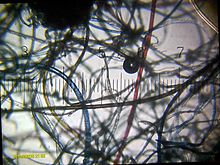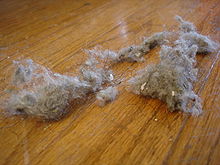- Dust bunny
-
For the album by Bettie Serveert, see Dust Bunnies.
 Microscopic view of a dust bunny. Numbered ticks on the scale are at intervals of 230 µm.
Microscopic view of a dust bunny. Numbered ticks on the scale are at intervals of 230 µm.
Dust bunnies (or dustbunnies), also called dust mice, are small clumps of dust that form under furniture and in corners that are not cleaned regularly. They are made of hair, lint, dead skin, spider web, dust, and sometimes light rubbish and debris, and are held together by static electricity and felt-like entanglement.[citation needed] They can house dust mites or other parasites, and can lower the efficiency of dust filters by clogging.[1] The movement of a single large particle can start the formation of a dust bunny.[2]
Dust bunnies are harmful to electronics, as they can obstruct air flow through heat sinks, severely raising temperatures and shortening the life of electronic components.[3]
A trademark for "Dustbunny" was registered in 2006 for the "Dustbunny Cleaner", a robotic ball with an electrostatic sleeve that rolls around under furniture to collect dustbunnies and other material.[4][5]
Dust bunnies have been used as an analogy for the accretion of cosmic matter in planetoids.[6][7]
References
- ^ Dust Control in Finite Air Volumes at Zero Gravity - Mean-Field Like Analysis. T.R.Krishna Mohan, Surajit Sen. 8 April 2004.
- ^ Dust and fibers as a cause of indoor environment problems. T. Schneider. Scandinavian Journal of Work, Environment & Health. 2008.
- ^ Three Easy Ways to Save Your Computer From an Early Retirement. Christian Science Monitor. Chris Gaylord. April 15, 2010.
- ^ http://www.trademarkia.com/dustbunny-78490362.html USPTO Dustbunny Trademark
- ^ A Method and Apparatus for self-propelled cleaning. Bradford Morse et al. United States Patent Application Publication, US2006/0054187 2006 A1
- ^ Formation of Cosmic Dust Bunnies. Matthews, L.S. Hayes, R.L. Freed, M.S. Hyde, T.W. IEEE Transactions on Plasma Science. April 2007.
- ^ Comet Dust Bunny. George Musser. Scientific American. October 24, 2005.

This waste-related article is a stub. You can help Wikipedia by expanding it.

